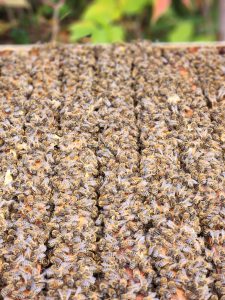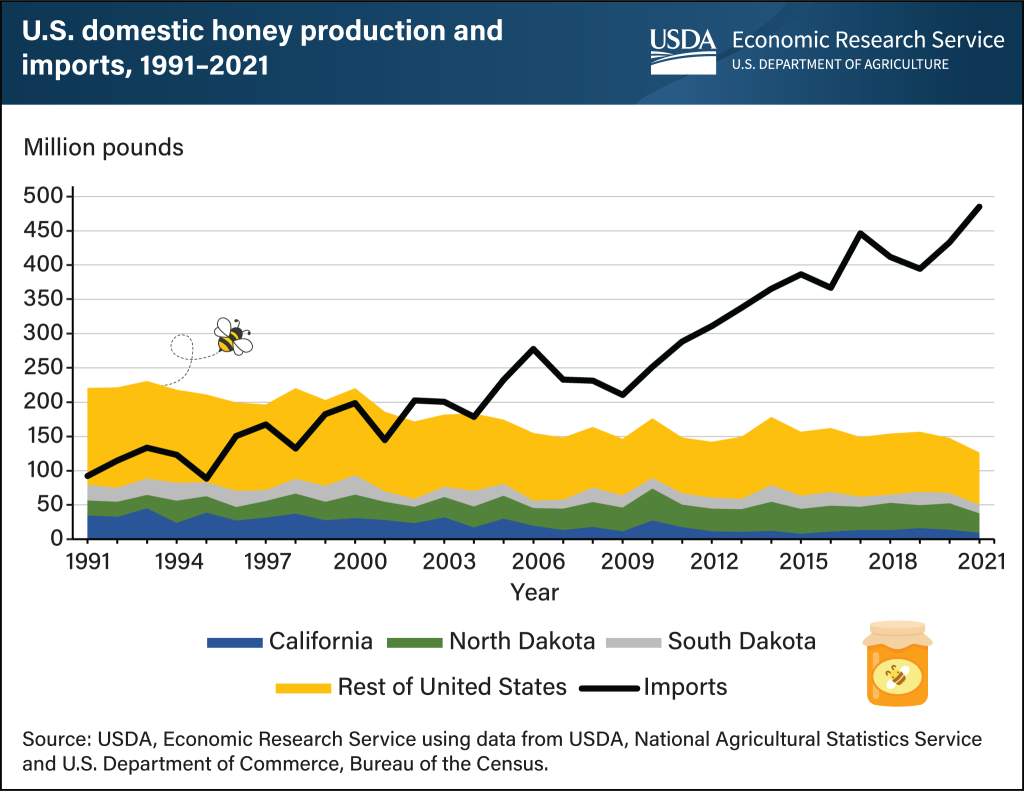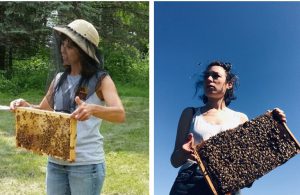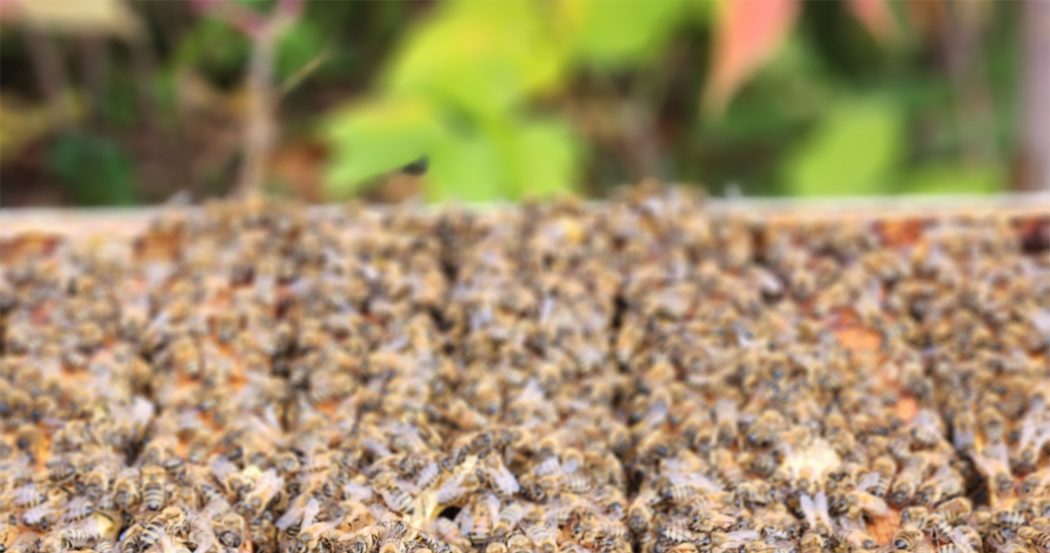Defend Beekeeping
By: Becky Masterman & Bridget Mendel

Beekeepers see a healthy, populous colony, but those concerned about native bee fitness see a colony of non-native bees with an overwhelming foraging force collecting pollen and nectar needed by threatened or endangered bee species. If beekeepers unite and plant our way out of the current honey bee habitat crisis, this thriving colony can be an indicator of a nutritious landscape that supports all pollinators and beneficial insects. Photo credit: Rebecca Masterman
Whether your beekeeping year has already started or you are worried about the longevity of your Winter honey stores, we suggest adding a new item to your 2024 beekeeping season to-do list. This one ranks just below varroa control: defend beekeeping.
What? Defend your beloved hobby? Defend your generational livelihood? Defend a passion that is shared worldwide? Defend a managed pollinator that is critical to the success of U.S. agriculture? Yep.
You are probably either nodding your head in agreement right now or have executed a quizzical head tilt similar to that of your favorite pup. For those who might be confused, it is about to get even more bewildering. There is a strong and growing movement against honey bees and beekeeping from a coalition of scientists, conservationists and the public who are worried about their impact on native bees. The new threat to honey bees is their impact on the health and habitat of native bees.
As beekeepers struggle to keep their own colonies healthy, watch honey production trend to historical lows and anxiously plan for yet another mite invasion, research and outreach is targeting the beekeeping industry’s challenges as threats to the survival of some native bee species. Copious data have been generated that demonstrate competition for floral resources between honey bees and native bees. Other studies are investigating honey bee pathogens left by foragers on flowers. Competition and the potential for disease transmission between honey bees and native bees are real. If that wasn’t enough, those protecting rare native flowers are worried about honey bees negatively impacting pollination and success of endangered flora. Our girls are ambitious foragers, but not necessarily the most effective pollinators of each flower they visit. They arrive at floral resources in large numbers and can have a negative impact on native pollinators and flowers.
The data aren’t all stacked against honey bees when examining resource competition. Instead, some studies show that where honey bees thrive, so do native bees. Other research reports no observed impact of honey bees on native bees. While we could use all of our allotted words to describe this growing body of honey bee-native bee competition research, we prefer to use the rest of our space to highlight native bee enthusiast-beekeeper competition and beekeeper-beekeeper competition.
We have to recognize the Xerces Society for Invertebrate Conservation for their effective anti-honey bee messaging. A growing coalition of anti-beekeeping individuals has been built. We strongly disagree with their conclusions that honey bees need to be restricted only to agricultural areas or natural areas located at least two miles from at-risk bee and plant species. We disagree with their efforts yet understand that they come from a love of bees. But we love bees too. In fact, we have yet to meet a beekeeper who was anti-native bee. We have met plenty of beekeepers who didn’t know that this controversy was brewing and were surprised with the information. Other beekeepers are well aware of this emerging issue and are now finding it difficult to place their bees due to the efforts of policy promotion to reduce bee competition.

Figure 1. While total U.S. honey production has trended downward, honey imports have seen massive increases. Both the production decreases and import increases challenge the U.S. beekeeping industry.
We think that it is a great miss to pit one bee against all the rest of the bees. The USDA-NASS honey production and import data demonstrate massive honey production decreases over the last 30 years coupled with a massive increase in imports (Figure 1). These nectar producing flowers that are no longer reliably in the ground for honey bees, are also missing for native bees. Why aren’t scientists, conservationists, the public and beekeepers uniting to promote the need for improved and new habitat, and the need for improved agricultural policy that will help farmers and landowners support all pollinators?
Honey bees aren’t endangered and beekeeper messaging about saving the honey bees is frustrating native bee enthusiasts. We get it. When you are experiencing high rates of colony death, it feels right to put ‘save the honey bees’ on a t-shirt or promote beekeeping to try to keep colony numbers high. But, for those worried about a bee species not existing anymore, beekeepers misusing the word endangered or implying that honey bees need saving, is vexing. Beekeepers need to promote and advocate for honey bee health and habitat (not as catchy of a slogan, but technically more accurate).
What makes this native bee honey bee war even more frustrating is a lack of unity among U.S. beekeepers. Whether you are a backyard beekeeper with an apiary of one, or manage 20,000 colonies, you have more in common with each other than you might think. Coming together to promote effective habitat installations, pest and predator control, stock improvement and critical honey bee health research is important. Now is the time to put aside your beekeeping philosophy differences and recognize that a united industry is necessary in order to protect beekeeping and promote policy that supports honey bees.
How do we defend beekeeping in 2024?
- Recognizing and understanding honey bee-native bee competition issues is a good first step to understanding the nuances of anti-honey bee rhetoric.
- The U.S. boasts over 4,000 different species of native bees. Learn more about the bees in your state (Minnesota reports over 500 species!), rethink current “save the honey bee” messaging and make it clear to your local native bee enthusiasts that you “keep in peace”*. Then share #3.
- Floral resource competition can be virtually eliminated if we improve habitat for all pollinators. Utilizing resources from and supporting organizations like the Bee and Butterfly Habitat Fund and the USDA-NRCS Conservation programs can impact significant amounts of land. Engaging state and federal agencies, private landowners and businesses, homeowners, parks and other beekeepers to improve habitat should be a priority for every beekeeper.
- Form a coalition of backyard, sideliner and commercial beekeepers in your state to meet with your state department of agriculture and state conservationists. Share your industry needs and the importance of habitat improvement for all pollinators, managed and wild.
*https://en.wikipedia.org/wiki/I_come_in_peace

Becky Masterman earned a PhD in entomology studying honey bee hygienic behavior at the University of Minnesota and is currently a host for the Beekeeping Today Podcast. Bridget Mendel joined the Bee Squad in 2013 and led the program from 2020 to 2023. Bridget holds a B.A. from Northwestern University and an M.F.A. from the University of Minnesota. Photos of Becky (left) and Bridget (right) looking for their respective hives. If you would like to contact the authors with your own beekeeping defense measures or other thoughts, please send an email to mindingyourbeesandcues@gmail.com
Resources
USDA Honey Bee Resources
USDA ARS Importance of Honey Bees to U.S. Agriculture https://www.ars.usda.gov/oc/br/ccd/index/#public
Attractiveness of Agricultural Crops to Pollinating Bees for the Collection of Nectar and/or Pollen, 2015 (usda.gov) https://www.usda.gov/sites/default/files/documents/Attractiveness-of-Agriculture-Crops-to-Pollinating-Bees-Report-FINAL-Web-Version-Jan-3-2018.pdf
Research state and U.S. honey production https://quickstats.nass.usda.gov/
Resources about honey bee-native bee competition
Mallinger RE, Gaines-Day HR, Gratton C (2017) Do managed bees have negative effects on wild bees?: A systematic review of the literature. PLoS ONE 12(12): e0189268. https://doi.org/10.1371/journal.pone.0189268
Weaver, J.R., Ascher, J.S. & Mallinger, R.E. (2022) Effects of short-term managed honey bee deployment in a native ecosystem on wild bee foraging and plant–pollinator networks. Insect Conservation and Diversity, 15(5), 634–644. https://doi.org/10.1111/icad.12594
Learn about Xerces Society for Invertebrate Conservation honey bee messaging
We Need to Talk About Honey Bees – YouTube https://www.youtube.com/watch?v=_8XMgphEP1M
Honey Bees (Apis) | Xerces Society https://xerces.org/publications/non-native-species/honey-bees
Want to Save the Bees? Focus on Habitat, Not Honey Bees | Xerces Society https://www.xerces.org/blog/want-to-save-bees-focus-on-habitat-not-honey-bees
Planting Resources
USDA NRCS Conservation Programs https://www.nrcs.usda.gov/
Bee and Butterfly Habitat Fund https://www.beeandbutterflyfund.org/
Minnesota Extension and University of Minnesota Bee Lab Planting Resources https://beelablearning.cfans.umn.edu/planting_resources/







